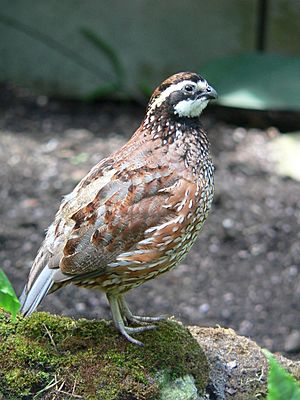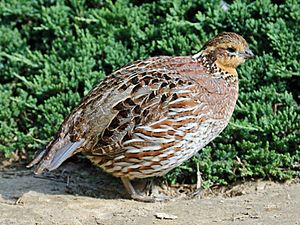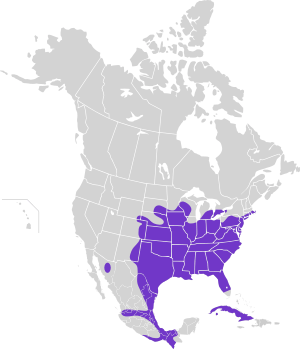Northern bobwhite facts for kids
Quick facts for kids Northern bobwhite |
|
|---|---|
 |
|
| Adult male | |
 |
|
| Adult female | |
| Conservation status | |
| Scientific classification | |
| Genus: |
Colinus
|
| Species: |
virginianus
|
| Subspecies | |
|
23; see text |
|
 |
|
| Synonyms | |
|
|
The northern bobwhite (Colinus virginianus) is a small, ground-dwelling bird. It is also known as the Virginia quail or bobwhite quail. These birds live in Canada, the United States, Mexico, and Cuba. They have also been introduced to other places like the Caribbean, Europe, and Asia.
The northern bobwhite gets its name from its special whistling call, which sounds like "bob-WHITE!" Even though they are shy, they are well-known in eastern North America. Sadly, their numbers have dropped a lot, about 85% from 1966 to 2014. This is mostly because their homes (habitats) are being damaged.
There are 23 different types, or subspecies, of northern bobwhites. Many of these are hunted as game birds. One type, the masked bobwhite (Colinus virginianus ridgwayi), is an endangered species. You can find wild masked bobwhites in northern Mexico and a group that was brought back to Buenos Aires National Wildlife Refuge in southern Arizona.
Contents
About the Northern Bobwhite
Different Types of Bobwhites
There are 23 known types of northern bobwhites. One type, the Key West bobwhite (C. v. insulanus), is no longer alive (extinct).
These different types are grouped into four main categories:
- Eastern bobwhites, found in places like Florida, Texas, and parts of Mexico.
- Grayson's bobwhites, found in west-central and eastern Mexico.
- Black-breasted bobwhites, found in eastern Mexico.
- Masked bobwhites, found in western Mexico and parts of the U.S.
What Does a Bobwhite Look Like?
The northern bobwhite is a medium-sized quail. It is the only small bird of its kind that lives in eastern North America. These birds are about 24 to 28 centimeters (9 to 11 inches) long. Their wings can spread from 33 to 38 centimeters (13 to 15 inches) wide.
Bobwhites have a round, chunky body shape. Their beak is short, curved, and dark brown. Male and female bobwhites look a little different.
- Males have a white throat and a white stripe above their eye. These white areas are outlined in black. Their body feathers are reddish-brown with gray spots on their wings. They have white stripes on their sides and black marks on their whitish belly. Their tail is gray.
- Females look similar but are not as brightly colored. They have a light brown (buff) throat and brow without the black outline.
Both male and female bobwhites have pale legs and feet.
Where Bobwhites Live
The northern bobwhite lives all year round in farm fields, grasslands, open forests, and along roadsides. Their home range covers the southeastern part of the United States. This goes from the Great Lakes down to southern Minnesota, and east to Pennsylvania and southern Massachusetts. It also stretches west to southern Nebraska, Kansas, Oklahoma, and most of Texas.
They do not live in the very southern tip of Florida or in the highest parts of the Appalachian Mountains. You can also find them in eastern Mexico and Cuba. They have been brought to other places like Hispaniola, the Bahamas, Puerto Rico, France, China, and Italy. Some groups have also been introduced in Oregon and Washington. Northern bobwhites have also been brought to New Zealand.
Bobwhite Sounds
The northern bobwhite is famous for its clear whistle that sounds like "bob-WHITE" or "bob-bob-WHITE." The sounds are slow and spaced out. The pitch of the call goes up a full octave from start to finish. They also make other sounds like soft whispers and quick warning whistles.
Bobwhite Behavior and Life
Like most game birds, the northern bobwhite is shy and likes to stay hidden. When it feels in danger, it will crouch down and stay still. It uses its camouflage to blend in with its surroundings. If something gets too close, it will quickly fly away low to the ground.
Early in the year, bobwhites usually live alone or in pairs. In late summer, you can often see family groups. In winter, many birds will gather together in a group called a "covey." A covey can have two dozen or more birds roosting together.
Reproduction and Family Life
Both male and female bobwhites can sit on the eggs to keep them warm. The eggs hatch after about 23 days. The baby bobwhites, called chicks, can leave the nest soon after they hatch.
Many nests fail because predators eat the eggs or chicks. However, bobwhites can try to nest again up to four times if their first nests don't work out. It is very rare for them to successfully hatch more than two nests in one nesting season. Sometimes, different families of bobwhites will join together, and parents might even adopt chicks from other nests.
What Bobwhites Eat
The northern bobwhite eats plants and small bugs. Their diet includes seeds, wild berries, and cultivated grains. They also eat small creatures like ticks, snails, grasshoppers, beetles, spiders, crickets, and leafhoppers. They look for food on the ground in open areas where there is some taller plant cover.
The amount of protein and energy bobwhites need changes. For example, a female laying eggs needs more protein (23%) than a male (16%).
Bobwhites and Humans
Bobwhites in Other Countries
Northern bobwhites were brought to Italy in 1927. They are now found in the plains and hills in the northwest of the country. They have also been reported in France, Spain, and Yugoslavia. Because bobwhites are easy to breed and are popular, they have likely been introduced in other parts of Europe, especially in the U.K. and Ireland.
Bobwhites in New Zealand
Between 1898 and 1902, about 1,300 bobwhites were brought from America to New Zealand. They were released in many parts of the North and South Islands. For a short time, people could hunt them in Nelson. However, it seems that too many were hunted, and the bobwhites soon disappeared from the wild.
More bobwhites were brought to New Zealand by private people in the 1990s. Now, there is a healthy group of bobwhites kept by people who raise birds. These birds are easy to care for and breed. They are popular because of their song and good looks. Many of these captive birds are kept by game preserves and bird breeders.
Keeping Bobwhites as Pets
Housing Bobwhites
Northern bobwhites can usually live with most parrots, softbills, and doves. However, they should be the only ground-dwelling birds in their enclosure. Most bobwhites will not harm smaller birds like finches. It's best to keep them in single pairs, unless they have grown up together in a group. Male bobwhites might fight during breeding season.
Bobwhites can be kept in open aviaries (large bird cages). But they might be shy in such places. In an aviary with plants, they usually become quite tame. When parents have chicks, they will sleep on the ground in a circle, with their heads facing outwards. In the morning and evening, the male will make his call. It's not very loud, but it carries well. Many breeding places keep bobwhites in groups on wire floors. This helps keep the birds clean and prevents diseases.
Feeding Bobwhites
In the wild, northern bobwhites eat many types of weed and grass seeds, as well as insects. They find this food on the ground or on low plants. In an aviary, they can easily eat a mix of small seeds (like finch or budgerigar mix) along with green plants. Live insects are not usually needed for breeding, but the birds will love them. Foods high in protein, like chicken feed, are also good for breeding birds. Laying hens need extra calcium, which can be given as shell grit or cuttlefish bone.
Breeding Bobwhites
In an open aviary, female bobwhites might lay eggs all over the place if they don't have a private nesting spot. If they do this, they can lay over 80 eggs in a season. These eggs can be taken for artificial incubation, and the chicks can be raised by hand. If a female builds a nest on the ground, she will lay 8 to 25 eggs in a group, laying one egg each day.
Different Types and Colors
Some bobwhites have been bred with other types of quail, like scaled quail, Gambel's quail, California quail, and mountain quail. There are also many different color types of bobwhites that have been created over time. These include Californian Jumbo, Wisconsin Jumbo, Northern Giant, Albino (all white), Snowflake, Blonde, Fawn, Barred, Silver, and Red.
Bobwhite Conservation Status
The northern bobwhite is considered a Near-threatened species by the International Union for the Conservation of Nature. This means their numbers are decreasing and they could become endangered. The main reasons for this are the loss and damage of their natural homes. Changes in how land is used and changes in fire patterns have made many areas unsuitable for bobwhites.
Protecting the Masked Bobwhite
The masked bobwhite subspecies (C. v. ridgwayi) is listed as endangered in the U.S. In the past, these birds were thought to be completely gone from Arizona. They originally lived in southern Arizona in the U.S. and northern Sonora in Mexico.
The masked bobwhite's population has been shrinking since it was first discovered in 1884. By 1900, it was already extinct in the U.S. Groups still lived in Mexico, but it was hard to study them because of political events there. A group of masked bobwhites was finally found and studied in Mexico in 1931 and 1932.
By 2017, the wild population in Sonora, Mexico, seemed to be declining or possibly gone. A study in 2017 found no wild masked bobwhites in Sonora. The decline is thought to be caused by too much livestock grazing in an area that doesn't recover quickly.
In the 1970s, a group of masked bobwhites was started in captivity in Arizona. In 2017, the George Miksch Sutton Avian Research Center (Sutton Center) began helping with conservation efforts. They started breeding masked bobwhites at the Sutton Center in Oklahoma. The goal is to release these birds back into the Buenos Aires National Wildlife Refuge (BANWR). In 2019, biologists from the Sutton Center brought 1,000 chicks to the refuge. In 2020, they planned to bring 1,200 more birds. These actions, along with past efforts, are helping to protect this endangered subspecies.
Images for kids
-
Plate 76 of The Birds of America by John James Audubon showing a Virginian Partridge.
See also
 In Spanish: Colín de Virginia para niños
In Spanish: Colín de Virginia para niños



